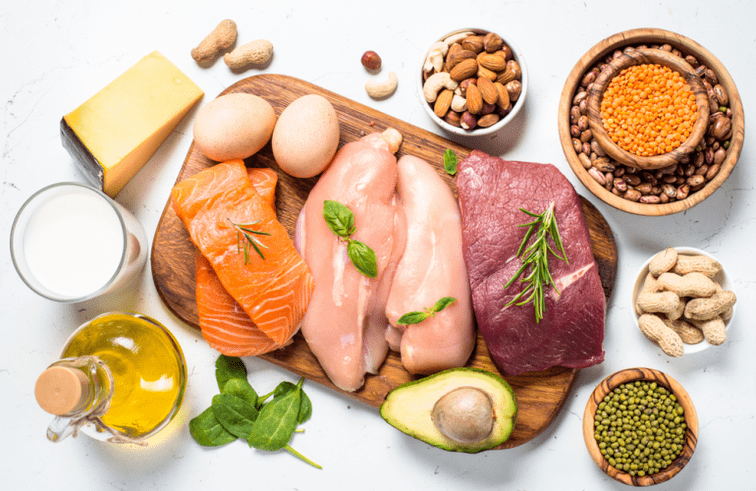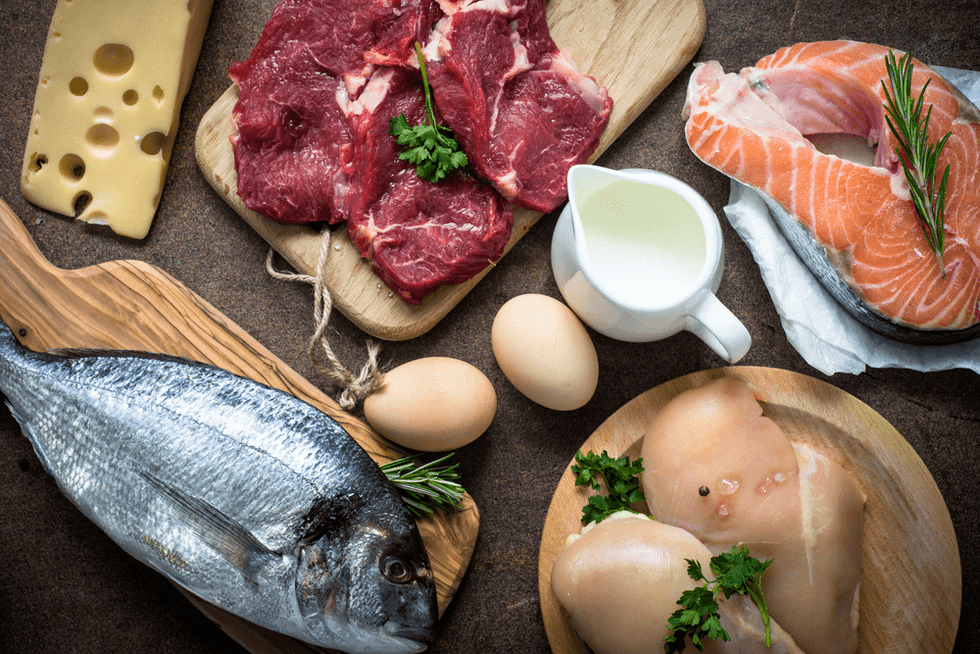
Excess weight in most cases is due to an excessive supply of adipose tissue, which accumulates due to the chemical transformation of carbohydrates entering the body. And although obesity is caused by certain disruptions in the endocrine and digestive systems, the most comfortable and painless solution to this problem is still to limit the source of excess calories during daily nutrition. day. By stopping or severely reducing the stomach accessibility of easily digestible carbohydrates with a carbohydrate-free diet, we automatically trigger a reaction that burns accumulated stores.
What is a zero carb diet
Based on a carbohydrate-free diet, athletes lose extra pounds before competition, artists before filming, and public figures when they need to get in shape. Athletes even have a special term for such nutrition. It is called "drying" - by eliminating carbohydrates from the diet, fat deposits under the skin are eliminated and the relief and elasticity of ligaments and muscles improve. But life without carbohydrates is a difficult challenge for people with a sweet tooth, who are forced to completely change their taste preferences, and for quite a long time. It requires not only determination but also quite a bit of patience and willpower.
There is also the other side of the coin - the complete rejection of carbohydrates in favor of protein products causes a condition that nutritionists call the not entirely accurate term carbophobia (literally, "fear of carbohydrates"). Avoiding a piece of bread or a piece of sugar like fire, not thinking about anything other than losing weight, sitting for months "eating omelets and cutlets", fans of a diet without carbohydrates are surewill certainly "cause" digestive and metabolic problems, in some cases disorders of the higher nervous system, memory loss, depression and social diseases.
Long-term or constant refusal of carbohydrates causes disorders of acid-base balance in the direction of acidification of the body, which inevitably leads to reduced immunity and premature aging. A side effect of a long-term low-carbohydrate diet is intestinal problems, kidney problems, arthritis, gout and other diseases.
Below we will consider some examples of carbohydrate-free diets and plans for its use, which will allow you to normalize metabolic processes, get rid of excess weight and at the same time not go totaken to the extreme, pumping the body to the max with animal-based proteins with chemicals and calories that are not at all harmless.
Biochemical and anatomical basis of low carbohydrate diet
The decisive argument for a low-carbohydrate diet is the specificity of the body's reaction to the introduction of small amounts of sugar into the stomach. The pancreas immediately begins to reflexively release insulin into the blood and digestive enzymes into the stomach, which immediately increases appetite (that is why it is said that appetitecomes with meals). As a result, when we eat carbohydrate-rich foods, we almost always eat more than we need. Protein-rich foods do not have such a seductive effect on the "pancreas", the production of hormones and enzymes occurs in an active sequence, saturation occurs gradually and fully. Protein is broken down in the digestive tract much longer than carbohydrates, so the feeling of fullness lasts for several hours and there is simply no need to snack if you eat three or four protein meals a day.
250 kcal rule
Most likely, it will not be possible to completely eliminate carbohydrates - simply because they are included in even completely protein dishes, albeit in minimal quantities. But this is nothing to be afraid of, the main thing is not to exceed the specified number of "carbohydrate" calories.
A low-carbohydrate diet certainly requires willpower, but using it can take a lot of discipline. Just remember a single number - 250. This is the number of energy units - calories, contained in the amount of carbohydrates that enter the body every day. Of course, we will have to carefully weigh all the dishes and calculate their energy value using special tables or notes on restaurant menus, but this is at almost no cost. unavoidable part of any strict diet.
Single-carbohydrate diet: effective but monotonous
A low-carbohydrate diet is ideal for rapid weight loss and is guaranteed to include separate meals daily - on the first day of the diet you eat only chicken, the second day - only eggs, third - only cheese or cottage cheese. This is the fastest way to lose weight but also the most "tasteless" and monotonous. Not everyone is ready for such sacrifices, so we will lose weight without fanaticism and combine business with pleasure - a healing effect with culinary pleasures, which is promised by the productsDelicious and healthy products based on animal and vegetable proteins.
By the way, the aforementioned vital 250 kilocalories of carbohydrates per day should also be obtained not from bread and sweets, but by harmoniously including complex carbohydrates (long to digest) in the diet - vegetables are not richStarch, grain, pure yeast-free grain bread.
Basic ingredients of a no-carb menu
Here is a list of protein-rich foods for a protein diet:
- lean meat - chicken, turkey, rabbit, veal;
- internal organs – stewed heart and liver;
- duck, chicken, quail eggs;
- fillet of sea fish, crab, shrimp, lobster, sea squid;
- dairy products - kefir, yogurt, cottage cheese, low-fat sour cream and hard cheese;
- leafy vegetables (cabbage), artichokes, green beans, beans, zucchini, onions, garlic, herbs from the garden. You can eat mushrooms but must be careful because mushroom protein is different from animal protein;
- sour berries and fruits, as well as avocados;
- nuts and seeds.
Meat and fish should be cooked by steaming, in the oven or at most on the grill, but not in a frying pan or deep frying.
A reasonable diet does not include sausages, sausages and pates that contain many questionable additives based on transgenic carbohydrates and fats.
When choosing a food supplier, you need to give preference to farms where meat and dairy animals are raised in comfortable conditions and do not receive various growth hormones and antibiotics in their feed. You should not trust the price tags in the supermarket - if you are on a diet, carefully read the instructions on the packaging and study in advance the list of food additives, many of which are harmful to health but are acceptable. used in the production of the infamous "health products".

Carbohydrates are prohibited
Now about the main thing for every diet - what is prohibited. On a low-carbohydrate diet, the following are prohibited:
- bread, other than unleavened whole grains;
- everything made from flour - pasta, pizza, pies, khachapuri, cakes, pastries;
- chocolate and confectionery;
- sweet and sour fruits and berries;
- starchy vegetables (potatoes, carrots, corn, beets);
- semi-finished industrial products. No matter what the manufacturer writes on the packaging, they almost always contain carbohydrate additives and preservatives, and even genetically modified fats;
- fruit juices and carbonated drinks;
- alcohol in any form.
Convinced meat eaters will find it difficult to resist a glass of red wine with their favorite steak, but here you have to choose: health or pleasure. Alcohol, in addition to its direct toxic effect on the body, is also a powerful appetite stimulant and a fairly high-calorie product - the calories obtained from it can be safely replenished. to 250 kcal, this is the daily limit for a protein diet.
Menu for 7 days

Monday
- Breakfast - Cheesecake made from low-fat cottage cheese with bran.
- Lunch - Vegetable salad with herbs, 200 g chicken breast with herbs.
- Snack - Orange.
- Dinner - Türkiye 100 g with stewed vegetables.
Tuesday
- Breakfast - Omelet with vegetable salad or stewed vegetables. Black tea without sugar.
- Lunch - Cream of vegetable soup with turkey or chicken pieces.
- Snack - Green apple.
- Dinner - Salmon baked in the oven.
Wednesday
- Breakfast - Unsweetened muesli with milk and dried apricots or other dried fruit.
- Lunch - Lentil soup with chicken breast.
- Snack - Almonds or other nuts (a handful).
- Dinner - Cherry tomato salad, arugula, canned tuna (1 can) and mozzarella cheese.
Thursday
- Breakfast - Oatmeal with unsweetened water. One banana (can be chopped and added to oatmeal).
- Lunch - Vegetable soup with veal meatballs.
- Snack - Orange or grapefruit, a glass of citrus juice.
- Dinner - Low-fat steamed fish.
Friday
- Breakfast - Mix 1 banana, a glass of fresh or defrosted cherries and a glass of milk. Mix in blender.
- Lunch - Chicken pilaf 200 g.
- Snack - Green tea with a piece of hard cheese.
- Dinner - Chicken or turkey with vegetable salad.
Saturday
- Breakfast - Egg white omelet. Tea without sugar. 1 banana.
- Lunch - 100g boiled chicken breast with brown rice.
- Snack - Sandwich made with unleavened bread, soft cheese, ham, lettuce and sliced tomatoes.
- Dinner - Stir-fried vegetables with meat. A glass of kefir or unsweetened yogurt drink.
Sunday
- Breakfast - 1 hard-boiled egg. Diet bread with hard cheese.
- Lunch - Cream of mushroom soup or wild mushrooms. You can add shredded turkey or chicken to the soup.
- Snack - Orange, green apple or some nuts.
- Dinner - Vegetable salad, 100 g of meat or fish baked in the oven.
Porridge for low-carbohydrate diets
Porridge on the water occupies a border position. When on a carbohydrate-free diet, 4 types of grains should be included in the menu:
| ARE NOT. | Name | Protein content | Carbohydrate content |
|---|---|---|---|
| first | buckwheat | eleven% | 68% |
| 2 | Green bean | 21% | 50% |
| 3 | Oatmeal | twelfth% | 65% |
| 4 | Quinoa | 14% | sixty four% |
Porridge is especially useful in the periods between periods of active weight loss, when you need to restore the balance between fats, proteins and carbohydrates in the body.
A questionable alternative: the keto diet In the United States, with its notorious fast food culture, a very popular type of carbohydrate-free diet is the ketogenic diet, which allows you to eat large amounts ofnot only protein but also animal fat. This plan has both supporters and opponents. The main argument of the latter is the harmful effect of fatty foods on the cardiovascular system, due to the deposition of cholesterol on the walls of blood vessels. It's hard to disagree with this.
Diet timing and preventive measures
The effects of the diet begin to appear after two to three weeks, with strict daily separate meals you can lose weight within a week of switching to protein. Limiting quickly digested foods will almost certainly cause intestinal disorders - constipation, bloating, due to the reduced content of vegetable fiber in food. When eating a meat menu or eating fish or seafood, you must drink at least two liters of liquid a day, eat soup and, if you are constantly constipated, take a mild laxative. After a month, to avoid the persistent development of carbophobia, you should take a break - from two to four weeks. It will restore the disturbed protein-carbohydrate balance and intestinal motility. While taking a break from dieting, you should not be too long: the diet must be balanced and strict, otherwise you will not only lose all the gains you have made, but will also increase the amount of fat accumulated and youwill have to start the fight against excess weight again.














































































